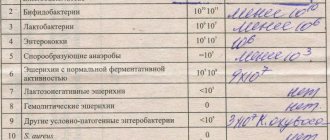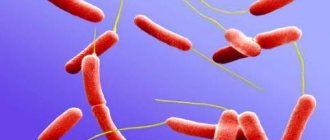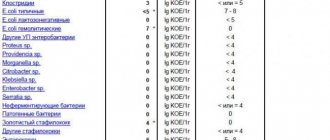Human immunity is directly related to the intestinal microflora, respiratory system and genital area. Tests for dysbacteriosis are a reliable and affordable way to clarify the origin of ailments and erect a reliable barrier to pathogenic strains. An imbalance, the disappearance of beneficial microorganisms, is often the root cause of many chronic diseases. Leads to the accumulation of toxins, atrophy of the gastrointestinal mucosa, poor absorption of vitamins and microelements, and activates the action of viruses.
Features of the analysis for dysbacteriosis
Feces are the end product of human life. They carry information about the quality and speed of absorption of nutrients, the condition of the organs involved in digestion. The main task of the analysis for dysbiosis is to provide information about the ratio of beneficial, harmful and opportunistic bacteria in the body. When the colony of beneficial species decreases, harmful bacteria begin to dominate the intestines unhindered, causing bloating, problems with stool, skin, abdominal pain, and general malaise.
The ambiguity of the reasons for the disruption of interaction between species significantly complicates the diagnosis of diseases. Therefore, in many cases, when clarifying the diagnosis and choosing tactics for successful treatment, key indicators in the analysis of stool for dysbacteriosis play a decisive role:
- Color, smell, consistency.
- Presence of undigested food particles.
- Presence of blood, mucus.
- Leukocyte count.
The obtained result of the study allows the doctor to notice in a timely manner
- presence of problems with the stomach, pancreas;
- the beginning of the inflammatory process;
- helminth infection;
- lack of beneficial microflora.
In order to monitor the dynamics of treatment, an extended analysis for dysbacteriosis can be prescribed to the patient repeatedly. In some cases, when a more in-depth examination is required, the patient must undergo additional tests for worms and enterobiasis, pathogenic bacteria.
By contacting the Euromedperstizh multidisciplinary clinic in Moscow, you will be confident in the quality of any tests. The bacteriological laboratory, equipped according to European standards, is our pride. Modern equipment and knowledge of advanced techniques allow us to perform traditional and unique clinical diagnostic studies. High accuracy of the results of stool analysis for dysbacteriosis, immunological study of urine, bile, blood and cerebrospinal fluid is guaranteed.
Analyzes are performed in 2 ways: traditional and inexpensive bacteriological and advanced biochemical, providing an answer within 1 day.
What is dysbiosis, why is it dangerous?
Dysbacteriosis is a condition in which the predominance of pathogenic and opportunistic microorganisms over beneficial bacteria is diagnosed in the intestinal microflora. As a result, the normal functioning of the gastrointestinal tract is disrupted, and there is a risk of developing many serious diseases due to the fact that the human immune system is very weakened.
There are several stages of development of dysbiosis:
Stage 1 – pathogenic bacteria are present in the intestines, but bad microflora does not develop rapidly. Unpleasant symptoms may not appear at this stage.
Stage 2 – there are few beneficial microorganisms, harmful bacteria are actively developing. The patient may have diarrhea and flatulence.
Stage 3 – beneficial microflora is not detected. Inflammation of the intestinal walls develops, chronic constipation or diarrhea appears, and the symptoms are painful.
Stage 4 – pathogenic organisms are active, they progress and deplete the body. Long-term predominance of harmful intestinal microflora leads to vitamin deficiency, anemia and other unpleasant conditions.
Rapid restoration of the gastrointestinal tract is possible only in the early stages; advanced variants are difficult to treat and can become a catalyst for the development of cancer and other dangerous ailments. That is why it is important to identify dysbacteriosis in a timely manner.
Indications for testing for dysbacteriosis
Living in an urbanized world of haste, constant stress, physical overload and poor nutrition leads to the destruction of beneficial intestinal microflora and, as a result, to a decrease in immunity. Actually, this is the essence of dysbiosis: there are a lot of bacteria, but there are few of them necessary for the human body. Frequent constipation, heartburn, nausea, belching, bad breath and even “snudges” in the corners of the lips are already a good reason to get tested for dysbacteriosis. In addition, the prerequisites for prescribing a bacteriological examination of stool are:
- flatulence, feeling of heaviness and discomfort in the stomach;
- persistent diarrhea, constipation, foul-smelling stool;
- noticeable loss of appetite, lethargy, drowsiness, black or gray stools;
- rejection of certain foods;
- previous treatment with hormonal drugs and antibiotics;
- severe forms of allergies that are difficult to treat conservatively;
- sudden weight loss, bloating, cheesy coating on the tongue;
- personal request of the patient.
The sudden appearance of a skin rash, unstable stool, mucus and blood in the excrement should also alert you. Only a specialist can determine the need for a stool test for dysbacteriosis: a therapist, an infectious disease specialist or a gastroenterologist. You can contact him with your complaints and symptoms that occur after consuming fatty heavy foods or alcohol. If the doctor considers the analysis necessary and useful for you, he will give a referral, and after receiving the result, he will provide a transcript for free. Prescribing a study on your own simply does not make sense.
Causes of imbalance
Any imbalance in the microbiota can cause dysbiosis. When an imbalance occurs in the gastrointestinal tract, it may result from:
- diseases of the digestive organs;
- infectious intestinal diseases;
- changes in diet (increasing protein intake, sugars or food additives, etc.);
- accidental consumption of chemicals, such as pesticides on unwashed fruit;
- drinking large amounts of alcohol;
- taking medications (hormonal drugs or antibiotics that affect intestinal microflora, etc.);
- poor oral hygiene, which can cause the proliferation of pathogenic bacteria;
- high levels of stress or anxiety, which can cause a weakened immune system.
Preparation and rules for collecting material
Strict adherence to the rules for preparing and taking samples of biomaterial is the key to the reliability of the result. To carry out the procedure, you must prepare the necessary container in advance - a pot or a duck. Wash thoroughly without using chemical detergents. Treat with medical alcohol and rinse with boiling water. Before defecation, perform hygiene of the anal area.
- For analysis of dysbacteriosis, stool obtained naturally without the use of laxatives and enemas is selected. Taking carrier medications and using medicinal suppositories should be stopped 3-4 days before submitting the material for research.
- 72 hours before the procedure, avoid drinking alcohol, meat, fish, and foods that color feces, change the smell and consistency. For example, beets, kiwi, blueberries, strong coffee.
- For 2-3 days, do not take medications that affect intestinal motility and accelerate the removal of food from the stomach.
- Women are not recommended to take a stool test for dysbiosis during menstruation.
- Collect the biomaterial in a sterile pharmaceutical container, tightly closed with a lid. Deliver to the laboratory within 4-8 hours. Do not freeze!
A sample taken earlier than 4 days after intestinal endoscopy or stomach radiography using contrast enhancers is considered unsuitable for research.
The most popular question, how to take 10-15 g of feces into a container, can be solved very simply. In order not to struggle with cotton swabs, matches and toothpicks, the easiest way is to use a plastic teaspoon.
Signs and symptoms
The nature of the symptoms depends on where the bacterial imbalance occurs and the types of bacteria, but common ones include: bad breath, upset stomach, nausea, constipation, diarrhea, bloating, rash or redness. In addition, they may include chronic problems: irritable bowel syndrome (IBS), inflammatory or autoimmune disorders, intestinal malabsorption, food allergies, atopic eczema, unexplained fatigue, arthritis, malnutrition, and others. Some side effects, such as stomach upset, are temporary. In such cases, the body can cope with them without the intervention of specialists. But if the symptoms become chronic and cause serious discomfort, then you need to consult a doctor to diagnose the causes and prescribe treatment.
Sources
- Du X., Liu J., Xue Y., Kong X., Lv C., Li Z., Huang Y., Wang B. Alteration of gut microbial profile in patients with diabetic nephropathy. // Endocrine - 2022 - Vol - NNULL - p.; PMID:33905112
- Zhou Y., Ye Z., Wang Y., Huang Z., Zheng C., Shi J., Tang W., Zhang P., Wang S., Huang Y. Long-term changes in the gut microbiota after triple therapy , sequential therapy, bismuth quadruple therapy and concomitant therapy for Helicobacter pylori eradication in Chinese children. // Helicobacter - 2022 - Vol - NNULL - p.e12809; PMID:33899288
- Huda MN., Kim M., Bennett BJ. Modulating the Microbiota as a Therapeutic Intervention for Type 2 Diabetes. // Front Endocrinol (Lausanne) - 2022 - Vol12 - NNULL - p.632335; PMID:33897618
- Gong X., Cai Q., Liu X., An D., Zhou D., Luo R., Peng R., Hong Z. Gut flora and metabolism are altered in epilepsy and partially restored after ketogenic diets. // Microb Pathog - 2022 - Vol155 - NNULL - p.104899; PMID:33894293
- Öhman L., Lasson A., Strömbeck A., Isaksson S., Hesselmar M., Simrén M., Strid H., Magnusson MK. Fecal microbiota dynamics during disease activity and remission in newly diagnosed and established ulcerative colitis. // Sci Rep - 2022 - Vol11 - N1 - p.8641; PMID:33883600
- Li Q., Larouche-Lebel É., Loughran KA., Huh TP., Suchodolski JS., Oyama MA. Gut Dysbiosis and Its Associations with Gut Microbiota-Derived Metabolites in Dogs with Myxomatous Mitral Valve Disease. // mSystems - 2022 - Vol6 - N2 - p.; PMID:33879495
- Chang TE., Luo JC., Yang UC., Huang YH., Hou MC., Lee FY. Fecal microbiota profile in patients with inflammatory bowel disease in Taiwan. // J Chin Med Assoc - 2022 - Vol - NNULL - p.; PMID:33871395
- Kaltenegger A., Humer E., Pacífico C., Zebeli Q. Feeding dairy cows bakery by-products enhanced nutrient digestibility, but affected fecal microbial composition and pH in a dose-dependent manner. // J Dairy Sci - 2022 - Vol - NNULL - p.; PMID:33865598
- Afroz KF., Reyes N., Young K., Parikh K., Misra V., Alviña K. Altered gut microbiome and autism like behavior are associated with parental high salt diet in male mice. // Sci Rep - 2022 - Vol11 - N1 - p.8364; PMID:33863940
- Wei R., Chen X., Hu L., He Z., Ouyang X., Liang S., Dai S., Sha W., Chen C. Dysbiosis of intestinal microbiota in critically ill patients and risk of in-hospital mortality . // Am J Transl Res - 2021 - Vol13 - N3 - p.1548-1557; PMID:33841678
What are the normal test results?
| Detectable bacteria | Norm |
| Pathogenic microbes of the intestinal family | |
| Typical E. coli (lactose fermenters) | 107 – 108 |
| E. coli lactose negative | Less than 105 |
| E. coli hemolytic | None |
| Microbes of the genus Protea | Less than 102 |
| Other opportunistic enterobacteriaceae | Less than 104 |
| Non-fermenting bacteria | 104 |
| Enterococcus | 105-8 |
| Hemolytic staphylococci (S.aureus, etc.) | None |
| Staphylococci (saprophytic, epidermal) | 104 |
| Bifidobacteria | 109-10 |
| Lactobacilli | 107-8 |
| Bacteroides | Less than 107 |
| Clostridia | No more than 105 |
| Yeast mushrooms | Less than 103 |
Determination of the content in feces of some short-chain fatty acids, which are metabolic products of microorganisms living in the intestines, the ratio of which changes with disturbances in the qualitative and quantitative composition of the intestinal microflora, caused by various functional and immunoinflammatory diseases of the gastrointestinal tract.
Synonyms Russian
Biochemical analysis of stool for dysbacteriosis, biochemical study of intestinal microflora.
English synonyms
Faecal short-chain fatty acids (SCFA).
What biomaterial can be used for research?
Cal.
How to properly prepare for research?
- Avoid taking laxatives, administering rectal suppositories, oils, limit (in consultation with your doctor) taking medications that affect intestinal motility (belladonna, pilocarpine, etc.) and drugs that affect the color of stool (iron, bismuth, barium sulfate), within 72 hours before stool collection.
General information about the study
A huge number of microorganisms live in various parts of the human body, more than half of them inhabit various parts of the gastrointestinal tract. About 90% of the intestinal microbiota consists of permanently inhabiting species of bacteria, just under 10% are accessory, or facultative, microorganisms, and less than 1% are transient - species that accidentally enter the intestine. One of the main aspects of the “mutually beneficial” coexistence of a person and the bacteria living in his intestines is their participation in the digestive processes. In particular, in the process of processing sugar-containing compounds, certain types of bacteria inhabiting the large intestine are capable of producing so-called short-chain fatty acids. This is a generalized name for organic compounds containing a relatively small number of carbon atoms and are considered biochemical markers of the symbiosis of the human body and the microflora inhabiting the intestines. Most of the short-chain fatty acids formed in the intestines are absorbed; about 5% of their total amount is excreted in the feces.
This study determines the content of short-chain fatty acids in feces, produced mainly by anaerobic microflora, which include:
- acetic – C2 (the designation indicates that the acid molecule contains two carbon atoms);
- propionic acid – C3;
- oil – C4;
- isobutyric – iC4 (isomers are characterized by the same atomic composition, but differ in spatial structure and, as a consequence, in some physical and chemical properties);
- isovaleric - iC5;
- isocapronic - iC6.
And also the calculated indicators:
- iso Cn/ Cn – the ratio of the total content of branched-chain acids (isomers) to straight-chain acids;
- AI - anaerobic index - the ratio of the sum of propionic and butyric acids to acetic acid.
Based on the results of numerous studies, it has been confirmed that through the participation of metabolic products of intestinal microflora, in particular short-chain fatty acids, in various biological processes of the human body, it performs a number of important functions, including metabolism and energy, stimulation of the immune system and blocking the activation of pathogenic flora, regulation intestinal motor activity.
Various types of microorganisms have the ability to preferentially synthesize one or another short-chain fatty acid. Pathological changes occurring in the gastrointestinal tract, and according to the results of some observations, even pathology not related to the gastrointestinal tract, lead to changes in the qualitative and quantitative composition of the intestinal microflora, which is also manifested by changes in the concentration of certain acids. At the same time, emerging disturbances in the intestinal microbiota contribute to the further preservation and progression of pathological changes.
Recently, diagnostic practice has increasingly included indirect studies of the composition of intestinal microflora by determining the content of various short-chain fatty acids in feces. Based on numerous clinical observations, types of changes in the composition of SCFAs have been proposed, which are parameters for choosing means of pharmacological correction. This technique made it possible to individualize the approach to treatment and, as a result, increase its effectiveness. In addition, based on the dynamics of changes in the composition of SCFA, the effectiveness of the therapy is monitored - with effective treatment, the quantitative and qualitative composition of short-chain fatty acids is normalized.
What is the research used for?
- To assess the state of intestinal microflora;
- screening and differential diagnosis of intestinal diseases, including as a clarifying test for functional gastrointestinal disorders;
- diagnosis of the activity and prevalence of the pathological process in inflammatory bowel diseases;
- selection of individual treatment for patients with gastrointestinal pathology and subsequent assessment of its effectiveness;
- diagnosis of insufficiency of exocrine pancreatic function in chronic pancreatitis.
When is the study scheduled?
- For symptoms of functional disorders of the gastrointestinal tract, as well as manifestations of inflammatory bowel diseases (for example, exacerbation of ulcerative colitis): diarrhea, constipation, abdominal pain, flatulence, etc.
What do the results mean?
Reference values
| Absolute content of acetic acid (C2) | 5.88±1.22 mg/g |
| Relative content of acetic acid (C2) | 0.634±0.015 Units |
| Absolute content of propionic acid (C3) | 1.79±0.95 mg/g |
| Relative content of propionic acid (C3) | 0.189±0.011 Units |
| Absolute content of butyric acid (C4) | 1.75±0.85 mg/g |
| Relative content of butyric acid (C4) | 0.176±0.011 Units |
| Absolute content of IsoCn (isoC4 + isoC5 + isoC6) | 0.631±0.011 mg/g |
| Relative content of IsoCn (isoC4 + isoC5 + isoC6) | 0.059±0.015 Units |
| IsoCn/Cn | 0.430±0.140 units |
| General content (C2+…C6) | 10.51±2.50 mg/g |
| Anaerobic index (C2-C4) | -0.576 (±0.110) Units |
The ratio of levels of various SCFAs reflects the predominance of certain types of bacteria in the intestinal microflora. Anaerobic microorganisms producing SCFA:
- acetic - Bifidobacterium, Lactobacillus, Actinomyces, Ruminococcus;
- propionic - Veillonella, Propionibacterium, Anaerovibrio;
- oily - Acidaminococcus, Bacteroides, Clostridium, Eubacterium, Fusobacterium, Lachnospira, Butyrivibrio, Gemmiger, Coprococcus;
- isoacids - Bacteroides, Megasphaera.
Total SCFA content is used to assess the metabolic activity of intestinal microflora. A low total SCFA content indicates a decrease in the metabolic activity of normal microflora, a possible decrease in colon motility, as well as a deficiency of food substrates. An increase in the total level of SCFA can be observed with excessive colonization of the colon by individual representatives of anaerobic microflora, increased metabolic activity, as well as with enzymatic deficiency and malabsorption.
Anaerobic index - reflects the ratio of strict anaerobes to aerobes and facultative anaerobes. Its increase is associated with suppression of the population of strict anaerobic microflora.
According to some research works, the following patterns of changes in the composition of SCFA have been identified in various intestinal pathologies :
- irritable bowel syndrome with a predominance of constipation is characterized by an increase in the content of acetic acid, an increase in the ratio of the total content of isoacids to straight-chain acids and a shift in the anaerobic index towards slightly negative values;
- in IBS with diarrhea and nonspecific ulcerative colitis, there is an increase in the concentration of propionic and butyric acids (however, the increase in butyric acid in UC is more pronounced), the anaerobic index is shifted towards sharply negative values; in addition, in IBS with constipation, the IsoCn/Cn ratio is reduced;
- Patterns of changes in SCFA content have also been identified depending on the localization of the process in ulcerative colitis : with distal lesions, the levels of propionic and butyric acids change in the same direction, with left-sided and total lesions their changes are multidirectional, with left-sided lesions the level of butyric acid increases, and with total lesions - propionic acid .
What can influence the result?
- Previous therapy with antimicrobial drugs changes the composition of the gastrointestinal microflora, so it is advisable to conduct the study at least 14 days after the end of antibiotic treatment. In this case, it is advisable to consult a doctor about the feasibility and optimal timing of this study.










